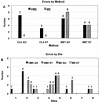Multilaboratory comparison of proficiencies in susceptibility testing of Helicobacter pylori and correlation between agar dilution and E test methods
- PMID: 14506021
- PMCID: PMC201128
- DOI: 10.1128/AAC.47.10.3138-3144.2003
Multilaboratory comparison of proficiencies in susceptibility testing of Helicobacter pylori and correlation between agar dilution and E test methods
Abstract
Susceptibility testing was performed at seven Canadian microbiology laboratories and the Helicobacter Reference Laboratory, Halifax, Nova Scotia, Canada, to assess susceptibility testing proficiency and the reproducibility of the results for clarithromycin and metronidazole and to compare the Epsilometer test (E test) method to the agar dilution reference method. Control strain Helicobacter pylori ATCC 43504 (American Type Culture Collection) and 13 clinical isolates (plus duplicates of four of these strains including ATCC 43504) were tested blindly. The National Committee for Clinical Laboratory Standards (NCCLS) guidelines for agar dilution testing were followed, and the same suspension of organisms was used for agar dilution and E test. Antimicrobials and E test strips were provided to the investigators. Methods were provided on a website (www.Helicobactercanada.org). Each center reported MICs within the stated range for strain ATCC 43504. Compared to the average MICs, interlaboratory agreements within 2 log(2) dilutions were 90% (range, 69 to 100%) for clarithromycin by agar dilution, with seven very major errors [VMEs], and 85% (range, 65 to 100%) by E test, with three VMEs. Interlaboratory agreements within 2 log(2) dilutions were 83% (range, 50 to 100%) for metronidazole by agar dilution, with six VMEs and eight major errors (MEs), and 75% (range, 50 to 94%) by E test, with four VMEs and four MEs. At lower and higher concentrations of antibiotic, E test MICs were slightly different from agar dilution MICs, but these differences did not result in errors. When a standardized protocol based on NCCLS guidelines was used, most participants in this study correctly identified clarithromycin- and metronidazole-susceptible and -resistant strains of H. pylori 93% of the time by either the agar dilution or E test method, and the numbers of errors were relatively equivalent by both methods.
Figures




References
-
- Al Qurashi, A. R., F. El Morsy, and A. A. Al Quorain. 2001. Evolution of metronidazole and tetracycline susceptibility pattern in Helicobacter pylori at a hospital in Saudi Arabia. Int. J. Antimicrob. Agents 17:233-236. - PubMed
-
- Bardhan, K., E. Bayerdorffer, S. J. Veldhuyzen van Zanten, T. Lind, F. Megraud, J. C. Delchier, M. Hellblom, A. Stubberod, C. F. Burman, P. Gromark, and L. Zeijlon. 2000. The HOMER Study: the effect of increasing the dose of metronidazole when given with omeprazole and amoxicillin to cure Helicobacter pylori infection. Helicobacter 5:196-201. - PubMed
-
- Bazzoli, F. 2001. Key points from the revised Maastricht Consensus Report: the impact on general practice. Eur. J. Gastroenterol. Hepatol. 13(Suppl. 2):S3-S7. - PubMed
-
- Bernstein, C. N., I. McKeown, J. M. Embil, J. F. Blanchard, M. Dawood, A. Kabani, E. Kliewer, G. Smart, G. Coghlan, S. Macdonald, C. Cook, and P. Orr. 1999. Seroprevalence of Helicobacter pylori, incidence of gastric cancer, and peptic ulcer-associated hospitalizations in a Canadian Indian population. Dig. Dis. Sci. 44:668-674. - PubMed
-
- Best, L. M., D. J. Haldane, G. S. Bezanson, and S. J. Veldhuyzen van Zanten. 1997. Helicobacter pylori: primary susceptibility to clarithromycin in vitro in Nova Scotia. Can. J. Gastroenterol. 11:298-300. - PubMed
Publication types
MeSH terms
Substances
LinkOut - more resources
Full Text Sources
Other Literature Sources
Miscellaneous

